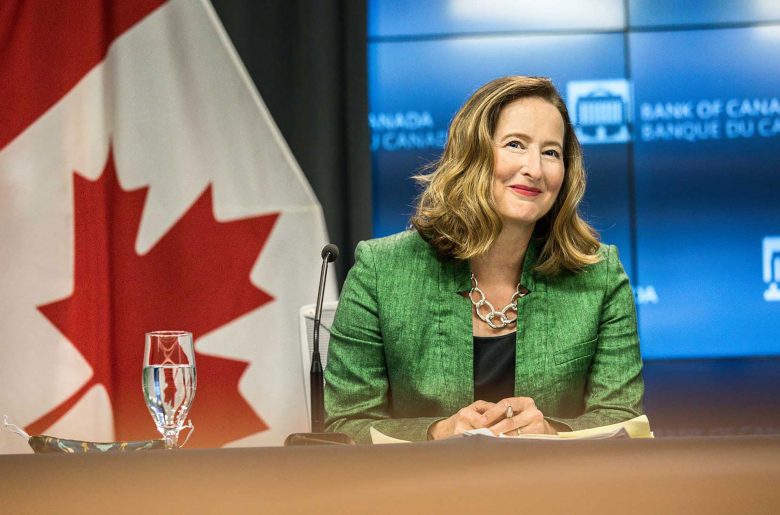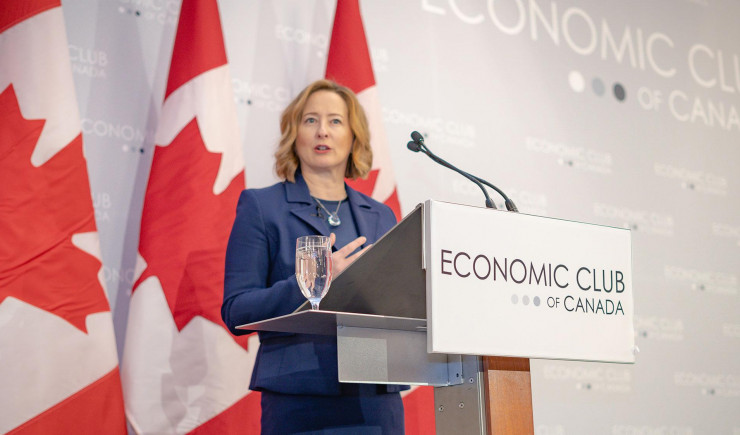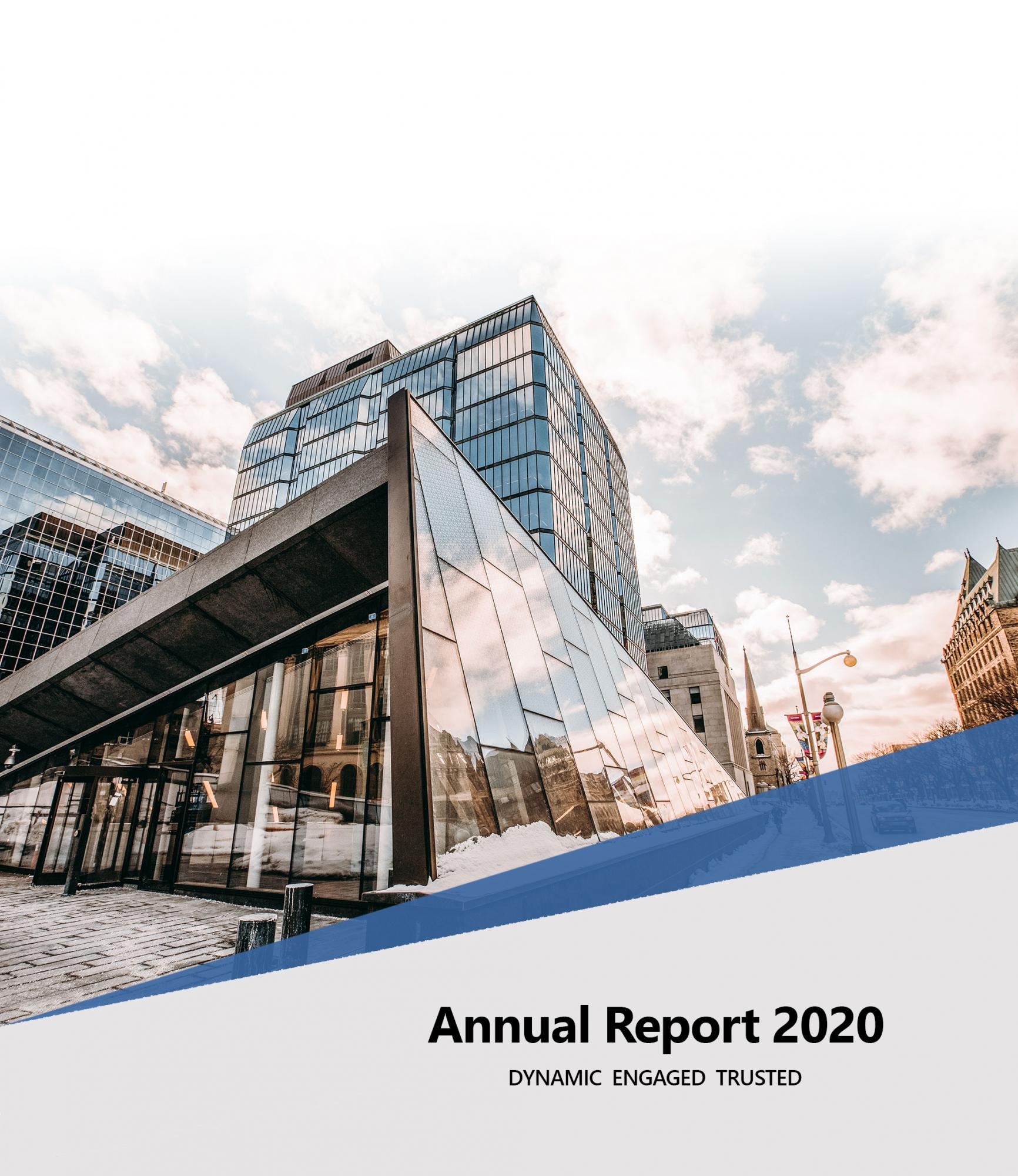

Governor's foreword
The year 2020 was like no other. It began with the unemployment rate in Canada near an all-time low, inflation very close to its 2 percent target and the Bank of Canada’s policy interest rate at 1¾ percent. Canada’s economy was healthy. To use Governor Stephen Poloz’s words in the foreword of last year’s Annual Report, “the macroeconomy has made it home.”
A year later, we are far from home.
By February 2020, COVID‑19 was spreading globally, and in March, Canada went into a lockdown. Thanks to the collective efforts of so many—health care providers, first responders, essential workers, governments, business leaders and every Canadian who took public health guidance to heart—a much worse catastrophe was averted. Nevertheless, the human and economic costs of the pandemic have been severe, and it’s not over.
The COVID‑19 pandemic took the lives of more than 15,000 Canadians in 2020. And with the virus continuing to spread, more Canadians will get sick—some with devastating consequences. In the spring of 2020, the economy plunged into the deepest recession on record—putting more than three million Canadians out of work—and inflation fell to zero.
Since then, the economy has climbed a long way back from the very deep hole it was in. But the recovery remains very incomplete. At the end of 2020, rising infections and new lockdowns were poised to worsen the economic situation in early 2021, before the rollout of new vaccines allows for a gradual return to more normal activities sometime later in the year.
For the Bank, too, 2020 was a year like no other. Confronted by extraordinary circumstances, the Bank’s employees worked with speed, determination and commitment to fulfill our role as Canada’s central bank. In the first half of the year, I watched this work from outside with great admiration. Since assuming my role as Governor in June, I have been even more impressed and proud of everyone at the Bank.
Despite significant professional and personal challenges, the Bank’s dedicated employees delivered an array of programs and policies to support the economy and the financial system. As the crisis hit, the Bank worked quickly to analyze the economic fallout of COVID‑19 in Canada and around the world. Against a background of extreme uncertainty, that analysis drove our critical policy decisions. These included our deployment of unprecedented tools to keep markets functioning and credit available and then later to provide the monetary policy stimulus needed to support economic recovery.
To address critical liquidity shortfalls in the financial system, the Bank designed and implemented 11 exceptional programs, 8 of which were entirely new. These included the new Standing Term Liquidity Facility, purchase programs for corporate and provincial bonds, and our Government Bond Purchase Program.
To support confidence and provide monetary policy stimulus, the Bank’s Governing Council made three emergency interest rate cuts, bringing the policy interest rate to its effective lower bound. In July, the Council committed to keeping it there until economic slack is absorbed so that the inflation target is sustainably achieved. The Bank reinforced and supplemented this exceptional forward guidance with a commitment to continue its large-scale asset purchase program until the recovery is well underway. This program has been effective in making borrowing more affordable for households and businesses.

Governor Tiff Macklem talks about the conduct of monetary policy in the context of COVID‑19 during his first public speech, hosted by the Canadian Clubs and Cercles Canadiens. Watch it on YouTube (June 22, 2020).
To ensure Canadians had the cash they wanted to hold during this period of uncertainty, we also worked with financial institutions and supply chain partners to quickly deliver a record number of bank notes.
The Bank’s rapid deployment of emergency measures to support the economy and the financial system reflected the immense effort that went into the Bank’s COVID‑19 response. Our incident management framework helped leaders across the Bank adapt their operations to new health protocols and policy requirements. Thanks to the Bank’s robust technology infrastructure, we swiftly transitioned to mandatory remote work while safeguarding the Bank’s critical operations. We also used our risk management framework to identify risks and address them as they materialized. Clear, timely and comprehensive communications—both internal and external—supported these efforts.
Despite the obstacles that arose, we also continued to complete important work related to ongoing priorities.
To lay the groundwork for the 2021 renewal of the Bank’s inflation-targeting agreement with the Government of Canada, we conducted a review of alternative monetary policy frameworks, presented the results to a diverse group of experts and stakeholders, and published them online. We also engaged with Canadians to better understand their perceptions of inflation. We will publish the results of this engagement in 2021.
We continued our important work to provide Canadians with bank notes they can use with confidence and pride. As we did with the very successful $10 Viola Desmond bank note, we launched a nation-wide campaign to ask Canadians who they want to see honoured on the new $5 bank note. We received more than 45,000 submissions for the portrait subject and published the shortlist of finalists. We also continued preparing for the future of money. As shifts in how Canadians use physical cash continued—and were accelerated by the pandemic—we made progress on the policy and technical planning for a central bank digital currency as a contingency.
The Bank continued its work to understand the implications of climate change for the economy and the financial system to help players in our financial system prepare. The Bank was appointed to the steering committee for the international Network for Greening the Financial System, which means we will play an important role in guiding its direction. We also began work with the Office of the Superintendent of Financial Institutions to create scenarios to help financial institutions and insurers do comprehensive and comparable climate-related scenario tests. Meanwhile, we set targets to reduce greenhouse gas emissions from Bank buildings.
Confronted by extraordinary circumstances, the Bank’s employees worked with speed, determination and commitment to fulfill our role as Canada’s central bank.”
In 2020, we found ways to reach out to groups that we have not engaged with enough in the past, particularly Indigenous Canadians. And the Black Lives Matter movement was a stark reminder of the need for further action to combat racism in our institutions and to create a truly inclusive work environment. More generally, it is important that the Bank reflect the people we serve and consider all points of view in our work for Canadians. To help achieve that goal, we launched a new diversity and inclusion strategy, introduced targets to increase the representation of women and racialized groups among our senior officers, implemented anti-racism actions and introduced new bursaries for students in visible minority groups.
The Bank’s achievements in 2020, particularly its operational resilience and rapid emergency response, are due in large part to the leadership and investments of Governor Poloz and Senior Deputy Governor Carolyn Wilkins.
Governor Poloz was an exemplary leader during his seven years at the helm of the Bank. When the crisis hit, the Bank was able to respond with speed, scale and ingenuity. This was largely the result of the Governor’s risk management approach to monetary policy, his deep understanding of the Canadian business community and his commitment to developing leadership.
Senior Deputy Governor Wilkins, who departed in December, was instrumental in designing and implementing the Bank’s emergency response measures. Over her tenure, she made the Bank a world leader in fintech and digital currency research and used her formidable intellect and passion to champion economic research. And, as the Bank’s first female Senior Deputy Governor, she inspired a generation of women who now see macroeconomics, and the Bank, as a place for them.
On behalf of the Bank’s Board of Directors and staff, I want to thank Stephen Poloz and Carolyn Wilkins for their tremendous service to Canadians. I am proud to continue their work as I enter my first full year as Governor of this great institution. Canadians count on us to promote their economic and financial well-being. I know that no matter what 2021 brings, we will carry out that mandate with unwavering dedication.
Tiff Macklem
Governor

2020 by the numbers
The COVID‑19 pandemic represented the most serious global health and economic crisis in over a century. In the face of extremely challenging personal and professional circumstances, Bank of Canada employees remained dedicated to ensuring that the institution could continue serving Canadians.
-5.5%
Canada’s real gross domestic product growth as estimated at December 31, 2020
0.7%
Consumer price index inflation
0.25%
Policy interest rate at year-end
78.54
US cents—Exchange rate for $Can1 as at December 31, 2020
$323.6
billion—Nominal value of marketable bonds issued in 2020
$194.8
billion—Nominal value of Government of Canada bonds purchased under its Government of Canada Bond Purchase Program
8
Number of iconic Canadians short-listed for selection as the portrait subject for the next $5 bank note
$346.4
thousand—Total staff donations to the Bank of Canada workplace charitable campaign—a record for the Bank

Mandate and planning framework
Mandate
The Bank of Canada is the nation’s central bank. Its mandate, as defined in the Bank of Canada Act, is “to promote the economic and financial welfare of Canada.” The Bank’s vision is to be a leading central bank—dynamic, engaged and trusted—committed to a better Canada.
The Bank has four core functions:
- Monetary policy: The Bank’s monetary policy framework aims to keep inflation low, stable and predictable.
- Financial system: The Bank promotes safe, sound and efficient financial systems within Canada and internationally.
- Currency: The Bank designs, issues and distributes Canada’s bank notes.
- Funds management: The Bank acts as fiscal agent for the Government of Canada, managing its public debt programs and foreign exchange reserves.
Efficient, cost-effective and innovative operations enable the Bank to achieve its business objectives.
Planning framework
The Bank’s robust planning framework puts its vision and mandate into practice. Every three years, the Bank establishes a medium-term plan (MTP) to set out its strategic direction, goals and indicators of success.
The MTP:
- helps the Bank anticipate and adapt to the realities of its operating environment
- guides annual planning and budgeting activities
- serves as the foundation for departmental and employee performance agreements
Reporting
The Bank is committed to:
- publishing information about how it works
- reporting on its financial and non-financial performance during the year
On this page
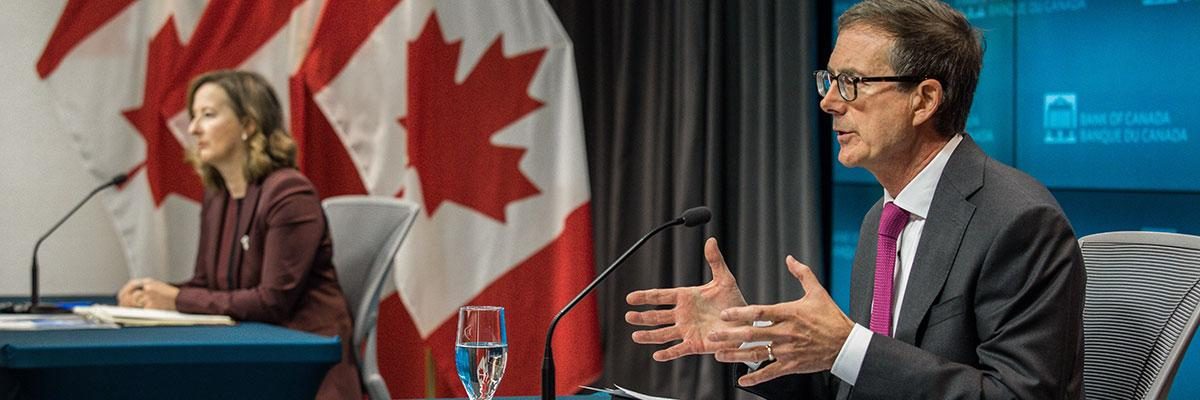
Monetary policy
Like other economies around the world, the Canadian economy was hit hard by COVID‑19. Following the onset of the pandemic and the introduction of measures to contain its spread, gross domestic product (GDP) fell by more than 10 percent in the first half of 2020.
Roughly half of that drop was recovered in the third quarter. But subsequent growth slowed significantly as the initial boost from reopening the economy faded. Moreover, rising numbers of COVID‑19 cases in the autumn and winter led governments to tighten physical distancing measures, weighing on the recovery.
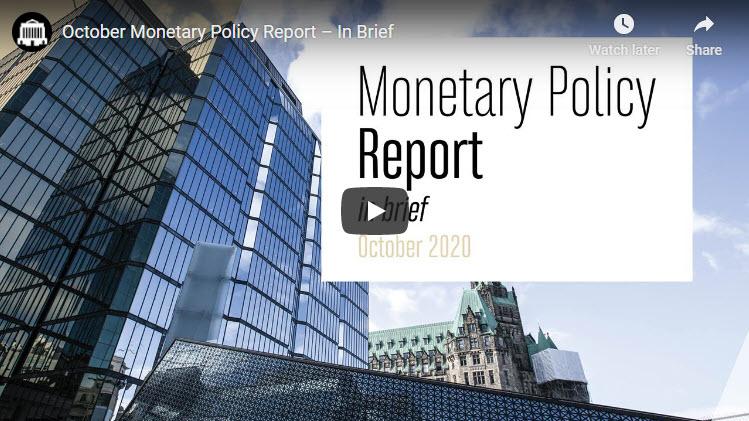
https://www.youtube.com/watch?v=zjJ3K3lp8zU
Assessing and responding to the effects of the pandemic
The pandemic had highly uneven effects across businesses1 and people.2
- Sectors that require social proximity—such as accommodation, food and restaurants—were hit hardest. Youth, low-wage workers and women were disproportionately affected because they often work in these sectors.
- Other sectors, such as goods and housing, fared better, helped by policy support and shifts in consumer preferences during the pandemic.
Government programs provided significant support to businesses and households.
Economic activity fell significantly as a result of the pandemic.3 While it partially rebounded through the summer as businesses reopened, growth then slowed due to ongoing adverse effects of the pandemic, including containment measures, elevated uncertainty, and suppressed business and consumer confidence.
Consumer price index (CPI) inflation was at the bottom of or below the Bank’s 1 to 3 percent target range from March through to the end of the year, consistent with an economy operating with considerable economic slack.
ICYMI: Deputy Governor Schembri said the second phase of the economic recovery could be bumpy: after an initial bounceback, the speed, strength and breadth of recovery are harder to predict. #economy #COVID19 #cdnecon http://ow.ly/b03b50AbErj pic.twitter.com/1273692467699879936
— Bank of Canada (@bankofcanada) July 18, 2020

https://twitter.com/bankofcanada/status/1273692467699879936
| Achievement of target for CPI inflation | ||||||
| Key indicators | Reference level | 2016 | 2017 | 2018 | 2019 | 2020 |
| CPI inflation | 2,0 | 1.4 | 1.6 | 2.3 | 1.9 | 0.7 |
| Average CPI inflation since 2001 | 1.8 | |||||
| Inflation expectations at a 10-year horizon | 2,0 | 2.0 | 2.0 | 2.0 | 2.0 | 2.0 |
The Bank took swift and decisive actions to help cushion the impact of the pandemic on the Canadian economy by:
- launching liquidity facilities and support programs early in the pandemic to support financial market functioning (some of these were discontinued as market functioning improved)
- lowering its target for the overnight rate to 0.25 percent in March 2020 and signalling in July—through extraordinary forward guidance4—that it would keep rates there until economic slack is absorbed and the 2 percent inflation target is sustainably achieved
- supplementing and reinforcing the rate cuts and forward guidance through a quantitative easing program5 to keep interest rates low
Low borrowing costs and well-functioning financial markets helped businesses adjust to the pandemic and supported household spending.
Supporting the Bank’s monetary policy function
Timely and thorough analysis supported monetary decisions in many ways throughout the year.
Bank staff mapped out a range of possible economic outcomes, which helped shape the narrative in the April Monetary Policy Report.6 As extreme uncertainty abated, they moved first to a central scenario and then back to a full projection.
The Bank collaborated with Statistics Canada to create an adjusted CPI to account for changes in consumption patterns due to the pandemic.7
Given how quickly the pandemic unfolded within Canada and globally—and how uneven its impact was—researchers relied on new forms of highly granular data to understand its economic impact. Staff added high-frequency data—ranging from restaurant reservations to transit ridership and payments information—to existing data sources. These data helped staff to:
- better assess the economic impact of the pandemic
- track how quickly global activity was coming back online when economies started to reopen
The use of such data is not new to the Bank. But lags in the publication of traditional data and the rapidly changing economic environment made these data all the more valuable in the policy-making process. Staff also expanded their use of surveys to better understand how the pandemic was affecting firms8 and consumers.9
Finally, staff continued working toward the renewal of the monetary policy framework—set to occur in 2021. Preliminary analysis compared several alternative policy regimes, weighing the relative benefits of each. A virtual conference collected input from external experts and explored lessons learned from the pandemic.10 (See Consulting with Canadians on inflation control for more information.) Staff also collaborated with Statistics Canada on a workshop on CPI measurement issues and the gap between perceived and actual inflation.
Looking forward
In 2021, the Bank will dedicate significant resources to further analyzing the effects of the pandemic on the economy. In addition, the Bank will:
- complete work related to renewing the monetary policy framework and publish research comparing the relative performance and strength of several alternative approaches to monetary policy
- continue to develop macroeconomic models that capture the complex relationship between monetary policy and the financial system
- analyze the structural changes to the economy resulting from digitalization, the pandemic, population aging and climate change, and consider their implications for monetary policy
- continue to explore opportunities to enhance the Bank’s economic models by incorporating new data sources and machine-learning techniques into economic forecasts and projections
- 1. Lawrence L. Schembri, “Our COVID‑19 Response: Navigating Diverse Economic Impacts," Bank of Canada The Economy, Plain and Simple (June 30, 2020).[←]
- 2. Tiff Macklem, “Economic Progress Report: A Very Uneven Recovery” (remarks to the Canadian Chamber of Commerce, Ottawa, Ontario, September 10, 2020).[←]
- 3. Supply was also adversely affected by the pandemic. For details see: Dany Brouillette, Julien Champagne and Julien Mc Donald-Guimond, “Potential Output in Canada: 2020 Reassessment,” Bank of Canada Staff Analytical Note No. 2020-25 (October 2020).[←]
- 4. Bank of Canada, “Bank of Canada Will Maintain Current Level of Policy Rate Until Inflation Objective Is Achieved, Recalibrates Its Quantitative Easing Program,” press release (October 28, 2020).[←]
- 5. Paul Beaudry, “Our COVID‑19 Response: Large-Scale Asset Purchases,” Bank of Canada The Economy Plain and Simple (August 25, 2020).[←]
- 6. Bank of Canada, Monetary Policy Report (April 2020).[←]
- 7. Kim Huynh, Helen Lao, Patrick Sabourin and Angelika Welte, “What Do High-Frequency Expenditure Network Data Reveal About Spending and Inflation During COVID‑19?” Bank of Canada Staff Analytical Note No. 2020-20 (September 2020).[←]
- 8. Bank of Canada, “Box 1: Flexible logistics solutions are helping manage supply chain challenges,” Business Outlook Survey—Autumn 2020 (October 19, 2020).[←]
- 9. Bank of Canada, Canadian Survey of Consumer Expectations—Third Quarter of 2020 (October 19, 2020).[←]
- 10. Bank of Canada, “Towards the 2021 Renewal of the Bank of Canada’s Monetary Policy Framework (Webcast)” (August 26, 2020).[←]
On this page

Financial system
Canada’s financial system has so far been resilient during the COVID‑19 crisis.
Uncertainty early in the pandemic led to a widespread flight to cash and made it hard to sell financial assets.11 The Bank responded by providing exceptional liquidity support to financial markets, as did other central banks around the world. These actions helped to address problems with market functioning and confidence, rapidly eliminating the effects of the liquidity shock.
Canada’s financial system has functioned well—helping Canadians weather the economic storm. And the financial system will play an important role in fostering a robust recovery.
Vulnerabilities and risks
In May, the Bank’s Financial System Review published timely and insightful assessments of vulnerabilities to the financial system. This work provided helpful information to support Canadians’ understanding of the COVID‑19 crisis.
In other research, Bank staff used new sources of microdata to identify business sectors and households12 that were most at risk of bankruptcy. They also assessed the extent to which income support programs and payment deferrals could help these sectors and households weather the economic crisis. Staff also used a newly developed top‑down stress‑testing framework13 to assess the potential resilience of Canadian banks14 under the worst‑case scenario outlined in the April Monetary Policy Report.15
Later in 2020, staff conducted further analysis and found that households were managing to keep up with their debt payments, but that an increasing number of businesses will likely need financing in 2021 to get by.16
ICYMI: Deputy Governor Schembri said the second phase of the economic recovery could be bumpy: after an initial bounceback, the speed, strength and breadth of recovery are harder to predict. #economy #COVID19 #cdnecon http://ow.ly/b03b50AbErj pic.twitter.com/1331341904181649408
— Bank of Canada (@bankofcanada) Nov 24, 2020

https://twitter.com/bankofcanada/status/1331341904181649408
Promoting financial system resilience
In response to the economic impacts of COVID‑19, the Bank launched several new and modified liquidity facilities and asset purchase programs. Their aim was to:
- keep markets functioning and credit flowing
- allow interest rate cuts to work their way through the economy
As part of its efforts to reinforce the strength of the financial system over the long term, the Bank signed agreements with prudential regulators in British Columbia, Alberta, New Brunswick, Nova Scotia and Ontario. These agreements enable the Bank to provide secured loans through the Standing Term Liquidity Facility (STLF) to provincially regulated financial institutions in these jurisdictions, as needed. And, thanks to an agreement signed with the Government of Quebec, the Bank can also provide emergency lending assistance to the Fédération des caisses Desjardins du Québec.
Oversight of financial market infrastructures
The Bank’s oversight activities supported the functioning of financial market infrastructures (FMIs) throughout the pandemic.17 During the initial phases of the crisis, Bank staff worked with provincial regulators to monitor how designated systems were operating in the challenging environment. This work resulted in important adjustments to some operational and risk practices.
Outside of its pandemic response, the Bank continued to make progress on longer‑term structural changes for FMIs, including:
- designating Interac e‑transfer as a prominent payment system
- establishing the FMI Resolution Committee to carry out the Bank’s responsibilities as resolution authority
- supporting the transition of the Automated Clearing Settlement System to a new technology platform
- conducting policy analysis, developing a supervisory approach and engaging payment service providers in anticipation of new responsibilities in retail payments supervision
Domestic partnerships
Throughout the year, the Bank worked with federal and provincial authorities to monitor and assess stress on individual banks and on the financial system. In 2020, the Bank:
- supported the Office of the Superintendent of Financial Institutions’ decision to adjust the Domestic Stability Buffer in March. This adjustment helped financial institutions to continue lending to businesses and households
- led the creation of the Systemic Risk Surveillance Committee18 (with both provincial and federal members) to help assess vulnerabilities in the financial system—including the pandemic’s impact on ongoing vulnerabilities (e.g., cyber security)
- worked with its partners in the Canadian Financial Sector Resiliency Group (CFRG)19 at the beginning of the pandemic to make it easier to share operational information—helping promote a better understanding of potential operational risks
- continued to support Payments Canada’s program to modernize the country’s core payment systems
In the Bank’s work with Payments Canada, it made progress on key aspects of both Lynx (the new high‑value payment system due to replace the Large Value Transfer System) and Real‑Time Rail (the new retail payments infrastructure that will support instant payments between individuals and businesses). While mandatory remote work and physical distancing protocols slowed progress at various participating agencies, both payment systems are scheduled to be launched over the next two years.
Interest rate benchmark reform
In June, the Bank became administrator of the Canadian Overnight Repo Rate Average (CORRA) and began publishing this Canadian interest rate benchmark on its website using an improved methodology. The Bank established the CORRA Advisory Group20 to provide advice on any potential adjustments to the methodology that might stem from changes in repo market functioning or from emerging issues.
With the anticipated discontinuation of the London Interbank Offered Rate (LIBOR), global financial markets are shifting more to overnight risk‑free rate benchmarks such as CORRA. The Bank fully supports the shift of the Canadian financial system to CORRA, which it expects to eventually become the primary Canadian interest rate benchmark. The Bank is actively working with industry stakeholders through the Canadian Alternative Reference Rate working group to facilitate this change, which now also includes a review of, and recommendations for, the Canadian Dollar Offered Rate (CDOR).
Financial stability and monetary policy
The Bank’s ongoing efforts to integrate financial stability concerns into monetary policy were accelerated by the COVID‑19 crisis. For instance, the Bank responded to the crisis by launching several liquidity support programs to restore market functioning, keep credit flowing and ensure the effective transmission of monetary policy.
Throughout the year, staff assessed the impacts of the Bank’s crisis response. The results, published on the Financial System Hub, will feed into the Bank’s work toward renewing its inflation‑control target agreement with the Government of Canada in 2021.
The Bank also made progress on its efforts to model the key links between financial stability and monetary policy decisions. With the next generation of monetary policy models, the Bank will be able to assess how, for example, house price expectations can amplify the boom and bust cycle.
The Bank’s efforts in this area were also supported by the newly created Heterogeneity Laboratory (HetLab). This is a collaborative online space where Bank researchers work on questions related to the role of variety in the circumstances of households and businesses (i.e., heterogeneity). Such work was critical to the Bank’s understanding of issues related to household savings and debt accumulation during the COVID‑19 crisis.21
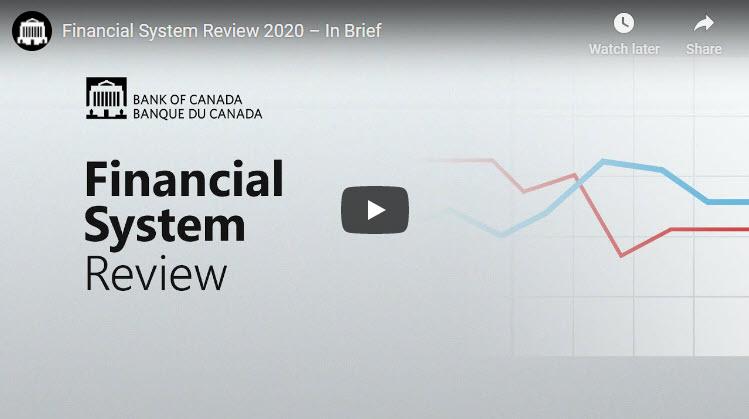
https://www.youtube.com/watch?v=79rmc1QKWNQ
Looking forward
In 2021, the Bank will continue to:
- use microdata to monitor the effects of the pandemic on households and businesses, especially service‑oriented businesses directly affected by physical distancing measures
- work with industry to ensure that the trading and settlement of Government of Canada bonds continues to function smoothly in a low‑rate environment
- work with Payments Canada and financial institutions to enhance the resilience of the country’s wholesale payments system
- work with stakeholders and the Department of Finance Canada to prepare for the Bank’s new role overseeing retail payment service providers
- conduct research as part of the monetary policy framework renewal exercise related to the design and effective implementation of various monetary policy tools and to the role macroprudential policies play in complementing monetary policy
- incorporate financial stability considerations into monetary policy, including those arising from household heterogeneity
- 11. Bank of Canada, Financial System Review (May 2020).[←]
- 12. Olga Bilyk, Anson T. Y. Ho, Mikael Khan and Geneviève Vallée, “Household Indebtedness Risks in the Wake of COVID‑19,” Bank of Canada Staff Analytical Note No. 2020‑8 (June 2020).[←]
- 13. Thibaut Duprey, Xuezhi Liu, Cameron MacDonald, Maarten van Oordt, Sofia Priazhkina, Xiangjin Shen and Joshua Slive, “Modelling the Macrofinancial Effects of a House Price Correction in Canada,” Bank of Canada Staff Analytical Note No. 2018‑36 (November 2018).[←]
- 14. Bank of Canada, “The Financial System Remains Resilient,” Financial System Review (May 2020).[←]
- 15. Bank of Canada, Monetary Policy Report (April 2020).[←]
- 16. Toni Gravelle, “Taking the Pulse of Canada’s Financial System” (speech to Autorité des marchés financiers, Montréal, Quebec, November 23, 2020).[←]
- 17. Bank of Canada, “Regulatory Oversight of Designated Clearing and Settlement Systems.”[←]
- 18. Bank of Canada, “Box 1: Collaboration through the Heads of Regulatory Agencies,” Financial System Review (May 2020).[←]
- 19. Bank of Canada, “Bank of Canada Announces Partnership to Improve Resilience in Financial Sector,” press release (June 27, 2019).[←]
- 20. Bank of Canada, “CORRA Advisory Group.”[←]
- 21. James (Jim) C. MacGee, Thomas Michael Pugh and Kurt See, “The Heterogeneous Effects of COVID‑19 on Canadian Household Consumption, Debt and Savings,” Bank of Canada Staff Working Paper No. 2020‑51 (November 2020).[←]
On this page

Responding to the crisis: extraordinary operations
In response to the COVID‑19 crisis, the Bank designed and launched a suite of liquidity facilities and asset purchase programs. These tools were integral in restoring market functioning and in keeping credit flowing to the economy. Combined with the Bank’s extraordinary forward guidance, they also enabled interest rate cuts to work their way through the economy. While adapting to physical distancing protocols and remote work, Bank employees worked quickly to set up these extraordinary facilities, which were unprecedented in both their scale and scope.
The Bank launched or expanded 11 special liquidity and asset purchase facilities (8 of which were entirely new). The Bank also enlisted external asset management expertise to establish and manage three of these facilities.
In the first three months of its crisis response, the Bank’s various liquidity facilities and asset purchases injected more than $377 billion in total liquidity into the financial system. Overall, the Bank’s balance sheet nearly quintupled, from $120 billion in March to roughly $550 billion by the end of 2020. These purchases were mainly funded by an increase in settlement balances, which rose from $250 million before the crisis to close to $350 billion by the end of the year.
The Bank’s quantitative easing (QE) program initially contributed to help core markets return to normal functioning, then pivoted to providing additional monetary stimulus to support the economy and achieve the Bank’s inflation target. The QE purchases lowered longer-term interest rates that matter most for households and businesses. This complemented the policy rate cuts made by the Bank at the onset of the pandemic, which directly affected very short-term interest rates. As market functioning returned and the focus shifted to the economic recovery, the Bank discontinued or scaled back some of the short-term liquidity facilities during the latter half of 2020.
In addition to outright asset purchase programs, the Bank also provided short-term collateralized loans to sound financial institutions as part of its strategy to support liquidity in the financial system. This was done by significantly expanding the existing term repo program and by accelerating the launch of the new Standing Term Liquidity Facility (STLF).22 The availability of a public liquidity backstop ensured that sound financial institutions had continued access to funding. In particular, the STLF provided smaller financial institutions (that may not have access to other Bank-run liquidity facilities such as the Standing Liquidity Facility and the Contingent Term Repo Facility) with access to central bank liquidity by pledging assets (including mortgages).23
Enabling the response with enhanced operations
Extensive measures were put in place to ensure the Bank could continue to conduct its critical operations during the pandemic. This was challenging because some operations have security and technology requirements that depend on staff being onsite to conduct them.
To assure the health and safety of onsite staff, as well as the continuity of critical market operations, the Bank conducted these activities across five separate sites, supported by staff working from home. The Calgary Operational Site, opened in 2019, played a key role in enabling this approach, validating the decision to have a fully parallel operations site.
The volume of transactions was significantly higher in 2020 than in previous years
| 2018 | 2019 | 2020 | ||||
|---|---|---|---|---|---|---|
| Operation type | Q1 | Q2 | Q3 | Q4 | ||
| Total domestic operations | 680 | 676 | 192 | 382 (287) |
405 (253) |
298 (194) |
| Total extraordinary operations | 0 | 0 | 25 | 306 (237) |
330 (218) |
268 (164) |
| Total outsourced operations | 0 | 0 | 0 | 106 (50) |
115 (27) |
109 (27) |
Note: Values in parentheses represent the number of operations with take-up if different from total number of operations.
- 22. Bank of Canada, “Bank of Canada Launches the Standing Term Liquidity Facility,” market notice (March 19, 2020).[←]
- 23. The Standing Liquidity Facility provides overnight loans to direct participants of the Large Value Transfer System, and the Contingent Term Repo Facility can only be accessed by federally or provincially regulated financial institutions that can demonstrate significant activity in the Canadian money and/or bond markets.[←]
On this page

Funds management
The pandemic had a major impact on the Bank’s funds management activities in 2020. One of the Bank’s top priorities was supporting the extraordinary market operations implemented to address the COVID‑19 crisis. As the Government of Canada’s fiscal agent, it also provided policy advice on managing debt in response to the Government of Canada’s significant domestic funding needs.
Sources: Bank of Canada, Department of Finance Canada and Statistics Canada
The Government of Canada increased its debt issuance to finance its COVID‑19 economic response plan.24 The total principal amount to be borrowed in 2020–21 is $627–692 billion, which is $370–435 billion higher than the amount issued for 2019–20.
At the onset of the crisis, a large part of the government’s extraordinary borrowings were short‑term instruments, mainly treasury bills. Large amounts of these instruments could be issued quickly to raise needed funding. Since then, as outlined in its debt management strategy for the 2020–21 fiscal year,25 the government has shifted to issue a larger proportion of debt in longer‑term bonds. This will:
- help manage rollover risk
- take advantage of the low interest rate environment
Providing funds management policy and advice
The Bank acts as fiscal agent and banker for the Government of Canada.
The Bank:
- administers and provides advice on the federal government’s debt and foreign reserves
- develops, in cooperation with the Department of Finance Canada, policies and programs to manage Canada’s borrowing and investment activities
The uncertainty around the record level of domestic funding needs, as well as the general volatility in the markets, made this work more challenging than usual in 2020.
The Bank provided funds management advice to the government that was flexible and appropriate given the context of the pandemic. The objectives were to:
- ensure the government could continue to raise significant funds in an orderly manner
- allow for funding that could be increased or decreased (as needed)
- keep market disruptions to a minimum
Improving systems by automating processes
To reinforce its funds management, monetary policy and financial system functions, the Bank continued to improve its systems for domestic market and fiscal agent operations.
This included automating several regular operations the Bank uses to manage its balance sheet and promote the orderly functioning of Canadian financial markets. For example, operations for term repos26 and overnight repos27 are now more efficient. Regular updates for both are posted with minimal manual intervention on the Bank’s website.
For both the Bank and market participants, these enhancements:
- increased operational scalability
- updated processes
- reduced operational risk
Phasing out Canada Savings Bonds
The Bank continued to take important steps to update operations. These steps respond to the Government of Canada’s 2017 announcement of its intention to discontinue Canada’s Retail Debt Program. As part of this announcement, the government indicated that it would no longer issue new Canada Savings Bonds or Canada Premium Bonds. The outstanding retail debt has declined from $4.996 billion in 2017 to $0.825 billion at the end of 2020.
Looking forward
In 2021, the Bank will continue to:
- enhance tools for providing strategic advice on managing the government’s debt and foreign reserves (including improving financial models for both)
- update processes for unclaimed bank balances and retail debt
- develop a strategy to support returning outsourced operations for retail debt to the Bank by 2023
- deliver key controls to help meet the Banking Operations Financial Crimes Policy and mitigate the Bank’s exposure to financial crimes risk
- focus on the strength and flexibility of banking operations
- 24. Government of Canada, “Overview of Canada’s COVID‑19 Economic Response Plan,” Economic and Fiscal Snapshot 2020 (July 15, 2020).[←]
- 25. Government of Canada, “Annex 3: Debt Management Strategy for 2020–21,” Economic and Fiscal Snapshot 2020 (July 15, 2020).[←]
- 26. Bank of Canada, “ Term Repos.”[←]
- 27. Bank of Canada, “Overnight Repos.”[←]
On this page

Currency
The COVID‑19 pandemic affected the Bank’s currency function in a variety of ways.
A higher-than-usual demand for cash put pressure on bank note inventories and the Bank’s operations centres. Navigating these pressures required agility and innovation.
The Bank continued to conduct research on payment methods, including the ways in which the pandemic led to deviations from historical trends. This research informed the Bank’s ongoing work in various areas, including on central bank digital currency (CBDC).
Meanwhile, counterfeiting rates in Canada remained low in 2020.
Ensuring the continuous supply and distribution of bank notes
Early in the pandemic, the Bank worked with financial institutions and distribution partners to boost inventories of bank notes at the regional distribution centres. This action lowered the risk of disruptions to the transportation of bank notes during the lockdown, ensuring an uninterrupted supply of notes to all regions of the country.
The Bank’s Agency Operations Centres, responsible for processing the country’s bank notes, also played a vital role.
Keeping counterfeiting rates low
The cutting-edge security features of Canada’s bank notes make them easy to check and difficult to counterfeit. This is reflected in Canada’s low counterfeiting rate, which was 8 parts per million on December 31—well below the Bank’s target of 30 parts per million.
The Bank continued its research into bank note technologies and future security features. It also conducted a public information campaign to remind Canadians that $1, $2, $25, $500 and $1,000 bank notes would lose their status as legal tender on January 1, 2021. The Bank supported this Government of Canada initiative because it helps ensure that notes in circulation are current, secure and easy to use.
Engaging stakeholders
The Bank continued its counterfeit deterrence activities with retailers, lottery and gaming organizations, working with law enforcement, including the Royal Canadian Mounted Police.
Regional offices across the country:
- maintained strong relationships with local stakeholders
- continued to support public education in their respective districts
Faced with public concerns about the transmission of the COVID‑19 virus on bank notes, the Bank consulted with health experts. Their findings supported the view that handling cash is no riskier than touching other common surfaces. The Bank therefore urged retailers to continue accepting bank notes, advocating for Canadians who rely on cash to buy the products and services they need.28
Planning for the future of payments
The Bank continued to monitor the evolution of money and payments, while also furthering its own research into a potential CBDC.29
In an interview with ICYMI: On Oct 14, Deputy Governor Tim Lane discussed the future of money, including our exploration of a potential central bank digital currency.@DigitalChamber@The_RBWC#CBDCpic.twitter.com/NR3ixy79cL
— Bank of Canada (@bankofcanada) Oct 16, 2020

https://twitter.com/bankofcanada/status/1317171001088745474
The Bank determined there is no compelling case to issue a CBDC at this time. But it began planning for a future where one might be needed. In February, the Bank released a comprehensive document outlining recommendations and began engaging with policy makers, financial institutions and other central banks to help guide future work in this area.
As well, the Bank collaborated with six other central banks on a joint report30 that outlined:
- the underlying principles and core features of a digital currency
- how a digital currency could help central banks deliver their public policy objectives

Designing the next generation of bank notes
From January to March 2020, the Bank held an open call for nominations of an iconic Canadian to feature on the next $5 bank note. This call resulted in over 600 qualified submissions. An independent advisory council (informed by online focus groups, a public survey, historical research and academic reviews) short‑listed eight candidates from these submissions.
The Bank also created an Indigenous Advisory Circle to provide advice on how Indigenous peoples in Canada should be represented on future bank notes through symbols, images, patterns and other visual content. The group will also guide the Bank of Canada Museum on its collections, programs and exhibitions related to Indigenous peoples.
Looking forward
In 2021, the Bank will:
- announce the portrait subject for the next $5 bank note, subject to a final decision by the Minister of Finance
- continue its research into security features for future bank notes
- expand its research on the use of cash and digital currencies
- develop a new counterfeit deterrence model, in partnership with law enforcement agencies
More information
Cash and COVID‑19: The Impact of the Pandemic on Demand for and Use of Cash
Timothy Lane on the Future of Digital Currencies
Reminder: Changes to Legal Tender Status Will Take Effect in 2021
Sûreté Du Québec and Canada Border Services Agency Win Bank of Canada Counterfeit Prevention Award
- 28. Bank of Canada, “Update: Bank of Canada Asks Retailers to Continue Accepting Cash,” press release (May 28, 2020).[←]
- 29. Timothy Lane, “Money and Payments in the Digital Age” (speech to the CFA Montréal FinTech RDV2020, Montréal, Quebec, February 25, 2020).[←]
- 30. Bank of Canada, European Central Bank, Bank of Japan, Sveriges Riksbank, Swiss National Bank, Bank of England, Board of Governors of the Federal Reserve and Bank for International Settlements, Central Bank Digital Currencies: Foundational Principles and Core Features (Bank for International Settlements, 2020).[←]
On this page

Managing the Bank
The pandemic required the Bank to find innovative ways to manage its operations in 2020. Bank staff quickly implemented ideas and tools that were already in development and helped the Bank to adapt almost every aspect of its business to the challenging circumstances.
The Bank’s established framework for managing incidents and its uniform approach to business continuity planning were essential to its ability to respond quickly. Adaptable emergency response teams made informed choices aligned with:
- public health guidelines
- peer organization responses
In mid‑March 2020, the Bank transitioned to mandatory remote work for most of its employees, except for staff needed to conduct or support critical functions. The Bank has monitored and adapted to the environment as the situation changed throughout the year, shifting priorities and finding solutions to the many challenges that arose.
Focusing on our people
As one of Canada’s Top 100 Employers for 11 years in a row, the Bank prides itself on a people-first philosophy and a work environment that is second to none.
As part of this commitment, and to ensure it is attracting and developing employees that reflect the diversity of Canadians, in 2020 the Bank launched a comprehensive strategy to promote diversity and inclusion.
We're honoured to be named one of #CanadasTop100Employers for the 11th year in a row. We couldn't be prouder of our amazing, diverse team—committed to the economic and financial welfare of all Canadians @top_employers https://t.co/kWK1ev8gK8 pic.twitter.com/GLQWxYVDww
— Bank of Canada (@bankofcanada) November 13, 2020

https://twitter.com/bankofcanada/status/1327265216766357510
Supporting new ways of working during the pandemic
The Bank took important steps in 2020 to support the health and well‑being of employees and help them adapt to challenges associated with the COVID‑19 pandemic.
The Bank:
- offered exceptional support to its remote workforce by:
- allowing flexible work hours
- adapting its policies
- providing ergonomic and limited financial assistance for home office equipment
- expanding health benefits
- conducting surveys to gauge the need for additional support
- provided coaching and training for leaders on mental health issues and managing teams through a crisis
- developed systems for tracking and checking in on employees infected with the virus and for onsite employees self‑isolating for any reason
- implemented physical safeguards for employees conducting critical work onsite
Developing a workforce for the future
Despite the immediate challenges the pandemic presented, the Bank remained focused on ensuring its people would be prepared for future challenges.
It conducted a strategic workforce analysis of new, emerging and in‑demand skills that will enable the Bank to remain a leading central bank in a digital age. The results will be important to the Bank’s resourcing and strategic plans.
The Bank also continued to make important progress in enhancing its data and analytics capabilities and pursuing its digital transformation.
Investing in resilience
The Bank’s ongoing commitment to operational resilience enabled it to quickly:
- anticipate and adapt to emerging threats
- ensure the continuity of critical operations
Thanks to its investments in creating two parallel operational sites and in enhancing key technology infrastructure, the Bank successfully navigated the challenges it faced in 2020.
At the beginning of the pandemic, the Bank improved its information technology capacity to ensure it could support remote work for a long period. As a result, it quickly accommodated the bandwidth needs of employees. It also successfully supported the roughly 6,000 users across the country who access aspects of the Bank’s systems. These users include traders, the Office of the Superintendent of Financial Institutions, the Canada Deposit Insurance Corporation and members of Payments Canada.
At the same time, the Bank continued to monitor and manage the systems that support the Canadian financial system, such as those related to regulatory reporting, auctions, payments and settlements, and bank note exchange.
The Bank also worked with partners in financial institutions to establish secure remote access to critical banking applications—ensuring the availability of a reliable backbone for the Canadian financial system. As well, it continued to meet regularly with partners in the Canadian Financial Sector Resiliency Group to share operational status updates and discuss emerging issues.
#COVID19 presented a wide range of operational issues the Bank had never seen before. Here’s how we responded. #cdnecon https://t.co/yk2pKL2UR4
— Bank of Canada (@bankofcanada) August 7, 2020

https://twitter.com/bankofcanada/status/1291736726650617860
Enhancing the pension plan’s investment portfolio
The Bank of Canada Pension Plan is a fully funded plan provided by the Bank to its employees. In its role as administrator, the Bank continued its work to diversify assets within the plan’s investment portfolio. The Bank made these changes in response to the results of the 2018 triennial study of the plan’s assets and liabilities.
The findings suggested that increasing diversification could improve the plan’s efficiency by reducing risk for a similar level of expected return. Notably, the Bank began integrating environmental, social and corporate governance considerations into its evaluation of external asset managers in 2020.
Looking forward
In 2021, the Bank will:
- continue to monitor how the pandemic affects operations
- plan for the eventual return of staff to the Bank’s offices; this includes ongoing efforts to design a post‑pandemic workplace and new ways of working
- conduct a broad and coordinated review of its COVID‑19 pandemic response to enhance business resilience
- develop and launch its next medium‑term plan
- implement its diversity and inclusion strategy, with a focus on promoting inclusion through training and eliminating barriers to building a career at the Bank
- advance its strategies for digital transformation and enterprise data and analytics
- continue to improve its cyber security, as outlined in its cyber security strategy
- improve the strength of its information technology systems, including implementing the cloud-first strategy
More information
2019–2021 Cyber Security Strategy: Reducing Risk, Promoting Resilience.
On this page

Bringing diversity and inclusion to life
The Bank employs talented individuals from across Canada and around the world. It values and celebrates this diversity.
In 2020, the Bank launched a comprehensive strategy to put diversity and inclusion into practice. This is the latest step in fostering a work environment where all employees feel safe and valued for their individual contributions and unique perspectives.
Formalizing the Bank’s commitment to inclusion
Diversity and inclusion are key sources of strength in the workplace, helping the Bank make better decisions and policies in the service of Canadians. The Bank has focused on diversity and inclusion for years. The strategy launched in 2020 further formalizes the effort, coordinates the many initiatives already underway and raises the bar.
The strategy—which includes intended outcomes and measures of success—incorporates the principles of diversity, equity and inclusion into every aspect of the Bank’s work.
We need to create an environment of inclusion where the power of our experiences, identities and ideas creates the kind of workplace we aspire to.
Governor Tiff Macklem
Fostering a diverse workforce and enabling inclusive leaders
It is vital that the Bank, as a public institution, reflect the diversity of the Canadian population it serves.
To this end, the Bank’s strategy for diversity and inclusion lays out clear goals for representation of women and other designated employment equity groups,31 including specific goals for senior officers. The Bank seeks to achieve diversity goals through:
- education
- employee development
- outreach
- scholarship and recruitment programs
We’re honoured to be named a top diversity employer. We’re proud that our diversity makes us a leading central bank.
— Bank of Canada (@bankofcanada) Mar 6, 2020
To join our team, see our current job opportunities: http://ow.ly/uy7n50yEJC3 https://twitter.com/bankofcanada/status/1235935132806152195

https://twitter.com/bankofcanada/status/1235935132806152195
The renewed anti-racism movement that followed in the wake of racial injustices in the summer of 2020 highlighted the continuing need to recognize and address the harm and inequity that affects the lives of Black and other racialized Canadians as well as Indigenous Peoples. During this period, the Bank:
- shared a message from senior leadership to employees that condemned racism in all its forms
- facilitated the creation of a new employee resource group—embRACE—for Black, other racialized and Indigenous employees, and their allies
- engaged leaders and held listening sessions with employees
- developed a collection of resources on racism and anti-racism, accessible to all leaders and employees
Grassroots employee resource groups (ERGs) like embRACE play an important role in fostering dialogue on issues related to diversity and inclusion. The Bank’s ERGs include:
- Franconnexions (also created in 2020): highlighting Francophone cultures and creating an inclusive workplace that reflects and respects Canada’s linguistic duality
- Enabled: ensuring a barrier-free workplace, raising awareness of visible and non-visible disabilities and providing peer-to-peer support
- NGen (“New Generation”): building a supportive network for new Bank employees and spotlighting resources and development opportunities
- PotentiELLE: supporting the professional growth and development of women at the Bank
- Pride: creating a community of LGBTQ2S+ employees and their allies, raising awareness and providing education and social support on related issues
Building partnerships with diverse stakeholders
The strategy to activate diversity and inclusion highlights the importance of the Bank’s relationships with diverse external partners and stakeholders. On this front, the Bank continued to communicate and share practices with other central banks to enhance diversity and inclusion.
The Bank also continued to connect directly with diverse communities across Canada through its relationships with universities and other external organizations. These connections enable deeper, more meaningful dialogue and help support the Bank’s recruitment objectives.
Notably, the Bank continued to work closely with Indspire, a non‑profit organization that helps the Bank connect with Indigenous students in Canada.

The Bank welcomed Indigenous high school students from across the country as part of its partnership with Indspire. Students learned about the Bank’s work and career opportunities.
Looking forward
In 2021, the Bank will:
- continue to implement the new diversity and inclusion strategy, which will include ongoing dialogue with employees across the organization
- provide leaders with more tools and training for their role as diversity and inclusion champions
- promote diversity and inclusion in the next medium‑term plan
- identify and address biases and barriers to equal opportunities and outcomes at the Bank
- 31. Government of Canada, “Employment Equity Groups” (July 1, 2007).[←]
On this page

A central bank for a digital Canada
To remain a leader in a highly complex digital world, the Bank is undertaking a digital transformation. As a data-driven institution, the Bank understands the importance of providing its staff with the latest technology and data.
But the benefits of advanced analytics cannot be fully realized without also focusing on workplace culture. The Bank has adopted a holistic approach to going digital. The shift is more than simply adopting the latest tools and techniques. It is about redefining how employees:
- learn
- approach problems
- answer questions
- work together
In 2020, the Bank launched a comprehensive strategy for its digital transformation. The strategy lays out a structured approach to support the Bank’s ambition to become digital first in every aspect of its business. This work is vital to the Bank’s ability to promote the economic and financial well-being of Canada in a digital era. This year, for the first time, the Annual Report is entirely digital.
It’s true: robots are taking some jobs. But #digitalization is not all doom and gloom. Learn why. https://twitter.com/bankofcanada/status/1229826425357819906
— Bank of Canada (@bankofcanada) Feb 18, 2020

https://twitter.com/banqueducanada/status/1229826589464125440
Building a solid foundation: data skills and infrastructure
Data are the Bank’s most important digital resource. Over the past few years, major initiatives in renewing technology and services have laid the groundwork for transformation. They have significantly improved the Bank’s capabilities in:
- data management
- systems
- analytics
- data science
These investments empower employees by making it easier for them to access, manage, search and share data.
In 2020, the Bank launched a searchable data catalogue. It also introduced a highly secure data repository that enables researchers to access and work with sensitive microdata. Meanwhile, a growing data science division continued to advance work across Bank departments.
This foundational work served the Bank well early in the COVID‑19 pandemic. Bank analysts had access to a wide variety of non-traditional data to:
- increase understanding of the economic crisis
- inform policy-making
As part of a broader initiative to identify future skills that will be needed across the organization, the Bank launched a program that enhances data awareness, matures our data capabilities and encourages continuous learning in a diverse, stimulating work environment.
The Bank recognizes that cultivating a digital-first culture helps to attract, develop and retain highly qualified people. To that end, and in support of fostering a digitally able workforce, the Bank also supports the exploration and adoption of emerging technologies, including:
- intelligent automation
- quantum computing
- advanced cyber security
- digital learning
Focusing transformation efforts where it matters
The Bank’s new digital strategy provides a clear and structured approach to transformation that is tied directly to its mandate.
In 2020, senior leaders worked together to identify four business priorities for the strategy:
- enhancing economic analysis and policy action
- achieving operational efficiencies
- improving digital communications
- advancing work toward a central bank digital currency as a contingency
In this way, the strategy serves as an important lens. Decision-makers can focus digital efforts and investments where they can have the greatest possible impact—in the areas that matter most to the Bank.
A central tenet of the strategy is to engage and empower employees. It includes a set of broad digital-first principles that employees have enthusiastically begun to integrate into their daily work. This process reinforces digital thinking and ways of working across the organization.
This year, the Bank explored how it can continue to use new and emerging technologies to improve its analysis and operations. Several ideas were developed into proofs of concept, with some making it to full production. One of these applies natural language processing—a branch of artificial intelligence—to help analyze results from the Bank’s Financial System Survey. As with other advanced analytics experiments of this kind, it freed up staff time to be used on more value-added analysis.
The pandemic and mandatory remote work made it more difficult to collaborate with external experts. Despite this, the Bank continued to successfully conduct experiments through its Partnerships in Innovation and Technology Program, known as PIVOT.
Planning for a digital-first future
As the Bank heads into the final year of its current medium-term plan, efforts are already underway to develop the next plan. The Bank is committed to help guide Canada’s economy through the post-pandemic recovery. Digital transformation is key to this commitment. It will ensure the Bank can continue to capably fulfill its mandate in a rapidly changing digital world.
Looking forward
In 2021, the Bank will:
- continue to evolve its analytic environment, with an expanded data management function to meet the needs of broader types and increasing volumes of data
- improve capabilities in analysis, data science and advanced technology to use these data and new approaches in policy and research
- launch an enterprise learning platform and curated courses for employees to develop high-priority skills, including data and digital skills
- strengthen the capacity of economic analysis by adding new data science and artificial intelligence capabilities
- further the Bank’s use of data analytics in oversight and decision-making
- continue to partner with the Bank for International Settlements (BIS) on the launch of a new BIS Innovation Hub centre in Toronto
On this page

Communications and outreach
The COVID‑19 pandemic highlighted the importance of clear, accurate and timely communications in maintaining public trust. As the Bank worked to support the country’s economy with extraordinary measures, it kept market participants informed of its actions and made sure its policies and decisions were well understood by both the media and the general public.
The Bank found creative ways to connect with Canadians online. It successfully adapted its speeches, conferences and educational activities—including the Bank of Canada Museum—to a virtual format.
At the same time, the Bank deepened and broadened its relationships with a range of stakeholders from the public, the private sector and civil society. This included advancing key initiatives related to the:
- renewal of the inflation‑control target
- next $5 bank note
- potential for a future central bank digital currency
- supervision of retail payment service providers
- creation of the first‑ever central bank network for Indigenous inclusion
The Bank welcomed a new Governor partway through the year and introduced him virtually to Canadians and the world.
Today, Governor Macklem spoke about the impacts of #COVID19 on Canada’s #economy with @stuffaboutstuff of @thomsonreuters. #cdnecon https://twitter.com/bankofcanada/status/1321553200026128391
— Bank of Canada (@bankofcanada) Oct 28, 2020

https://twitter.com/bankofcanada/status/1321553200026128391
Delivering digital communications
Throughout the pandemic months of 2020, the Bank delivered clear and frequent digital communications about its actions in support of the economy and financial system.
Being transparent and accessible
Notably, the Bank emphasized explaining why it was taking these actions and how they worked. This transparency was particularly important in clarifying the Bank’s many asset purchase programs and the resulting substantial increase in its balance sheet.
The Bank’s commitment to accurate, automated and detailed financial reporting helped maintain public confidence and trust during a time of heightened scrutiny.
As well, the Bank communicated extensively on economic issues related to the pandemic—through virtual public speeches, regular background briefings, interviews with journalists, social media and a dedicated web page.
The Bank ramped up its communications to the general public through its digital magazine—The Economy, Plain & Simple. It also created a series of accessible articles, videos and animations to explain its response to the COVID‑19 crisis. These covered everything from quantitative easing to payment systems.
Creating a virtual museum experience
The pandemic forced the Bank of Canada Museum to close in March 2020. Staff continued to care for the National Currency Collection while:
- developing several new virtual educational resources for the Museum’s website
- transforming popular onsite activities—including lesson plans and teacher discussion guides—into digital presentations
The Bank also continued to promote the Museum’s educational resources through virtual conferences, webinars and a new monthly newsletter.
The closure enabled the Museum to make progress on some longer‑term accessibility initiatives. These include improving the visitor experience for when the building re‑opens to the public.
Advancing key stakeholder initiatives
Throughout the pandemic months of 2020, the Bank continued its public opinion research program and engaged virtually with key stakeholders on several important initiatives.
Measuring public opinion
Knowing that public opinion can be volatile in times of crisis, the Bank initiated pulse checks to monitor changes in how people view the Bank and how much they trust and support it.
Results showed:
- increased attention on the economy and the Bank
- sustained levels of trust in the institution
- support for its pandemic response
This research is invaluable in understanding how a crisis can shape public opinion. It also helps to guide the Bank in developing communications products to meet the public interest. The Bank will continue to closely monitor public opinion throughout—and after—the COVID‑19 crisis.
Consulting with Canadians on inflation control
From August to October 2020, the Bank conducted its first‑ever Canada‑wide public consultation on the renewal of the inflation target. More than 8,500 people participated from every province and territory. This input will help the Bank to understand:
- how different segments of the public are affected by the current inflation‑targeting framework
- how they may view alternative monetary policy regimes
These insights lay vital groundwork for the 2021 renewal and will be used to inform the policy process.
ICYMI: While in Quebec City last week, Deputy Governor Beaudry gave an interview to @judithdesmeules of @cyblesoleil to discuss his role at the Bank and the state of the Canadian #economy. ow.ly/wY5X50yd9V2 pic.twitter.com/1224712383496687618
— Bank of Canada (@bankofcanada) February 4, 2020

https://twitter.com/bankofcanada/status/1224712383496687618
Building bridges with Indigenous groups
The Bank continued to build stronger ties with Indigenous‑led businesses and organizations in 2020. This included fostering an ongoing partnership with the Tulo Centre of Indigenous Economics. These relationships enable the Bank to better incorporate First Nations, Métis and Inuit perspectives into its policy initiatives and assessment of the Canadian economy.
As well, the Bank worked with the Reserve Bank of New Zealand and other central banks and their Indigenous partners to create a Central Bank Network for Indigenous Inclusion. The Bank also established an Indigenous Advisory Circle to provide guidance on Indigenous representation on bank notes as well as in the Museum’s exhibitions, collections and programs.
Promoting and supporting research
The Bank engages with academics, research partners and students through a variety of initiatives and programs.
The Bank also highlights current research through a monthly newsletter and website.
Looking forward
To ensure it remains a relatable and trusted Canadian institution, the Bank will:
- continue to communicate with Canadians about its policy actions and the economic recovery from the COVID‑19 pandemic
- consult with Canadians to improve its communications and stakeholder outreach—to build public understanding and deepen trust
- share the results of its public and stakeholder consultations on the renewal of the inflation‑control agreement
On this page

Global engagement
In 2020, the Bank used its influence to:
- help shape the global economic policy response to the COVID‑19 crisis
- promote a sustainable economic recovery
- maintain public confidence in the international financial system
By exchanging information and insights with global counterparts, the Bank deepened its understanding of the widespread impacts of the crisis. Given the extreme uncertainty that characterized much of the year, these insights were essential to:
- formulating monetary policy
- identifying risks to the financial system
Contributing to the international crisis response
As COVID‑19 spread around the world, governments and central banks took unprecedented fiscal, monetary and financial stability actions to support economic activity and maintain global financial stability.
Major central banks took coordinated action to enhance the provision of liquidity in the financial system using standing US dollar liquidity swap line arrangements. These swap lines served as an important liquidity backstop and helped to lessen the effects that strains in global funding markets had on the supply of credit to households and businesses, both in Canada and abroad.
In April 2020, G20 finance ministers and central bank governors released an action plan to set out the key principles guiding their response to the COVID‑19 crisis and committing to a recovery that is strong, sustained, balanced and inclusive. An updated plan was released in October, committing members to “do whatever it takes to support the global economy and financial stability, using fiscal, monetary and regulatory levers, in a complementary way for as long as required, and consistent with governments’ and central banks’ respective mandates.”32
G20 members also implemented the Debt Service Suspension Initiative, which is allowing eligible countries in need to suspend official bilateral debt service payments as they address health, social and economic challenges associated with the COVID‑19 pandemic.
The Bank of Canada worked with its counterparts in the G7 and G20 and on the Financial Stability Board to communicate the various aspects of the international response to the public.
High-quality staff analysis of the international economic situation helped the Bank influence the global policy dialogue. Through these discussions, the Bank promoted the importance of:
- strong macroeconomic frameworks
- open trade
- the need to minimize supply chain disruptions
- the consideration of digital and green opportunities in shaping the global recovery
Responding to data challenges
The Bank has chaired the G7 Central Bank Digitalization Working Group since 2018. In 2020, the group focused on the acceleration of digitalization across countries—as consumers shopped more online and firms adapted their business models in response to physical distancing measures. These rapid shifts in behaviour intensified the data challenges already associated with digitalization.
Official data frequently lag real-time developments and the pandemic created new types of information needs.
Central banks supplemented official data with alternative data sources to track economic developments in real time. The uncertain future course of the virus and whether it would lead to permanent changes in consumer behaviour challenged central banks’ core macroeconomic models.
The Bank played an important role in framing discussions about these data challenges and continued to promote the need for improved methods for measuring digital activity in the economy.
Enhancing cross-border payment systems
The continuing rapid pace of change in digital payments highlighted the importance of improving global cross-border payment arrangements. These improvements allow for transactions that are cheaper, faster, more inclusive and more transparent.
To this end, the Bank helped develop the Financial Stability Board’s road map for enhancing cross-border payments. This road map includes practical steps to support ongoing cooperation—in particular, in assessing the benefits and risks of financial innovation.
The Bank also helped draft the G7 statement on digital payments that outlines the need for global cooperation in assessing risks and formulating policy.
As part of a coalition of seven central banks and the Bank for International Settlements’ Innovation Hub, the Bank contributed to a paper on central bank digital currency (CBDC). This paper sets out some common principles guiding CBDC design and related policies. It also underscores the need for further investigation of the potential benefits of a CBDC for cross-border payments.
Important discussion on central banking with Carolyn Wilkins, @RichardClarida, Philip Lane & Tobias Adrian. In this “low for long” era, central banks must be innovative & bold to update their toolkits & find new ammunition to support the recovery. http://ow.ly/XhF350CtMYZ pic.twitter.com/GLQWxYVDww
— KGeorgieva (@KGeorgieva) November 24, 2020

https://twitter.com/KGeorgieva/status/1331317006390407172
Promoting international cyber security
The Bank continued to participate in a variety of international cyber security forums through organizations such as the G7 and the Bank for International Settlements. These networks were particularly critical this year, helping the Bank share information and discuss the cyber security implications of the crisis with:
- financial sector counterparts
- central banks
- peer organizations
Working with other financial sector authorities in the G7, the Bank also participated in a successful test of the international response protocol for cyber incidents. This protocol helps limit the potential damage caused by an international cyber incident by enabling G7 countries to respond coherently and cohesively.
As well, the Bank contributed to a G7 publication that lays out the important elements for cyber security exercises. These guidelines will shape the direction of future cyber exercises for the sector. Such exercises help the G7 to understand and address the systemic implications of potential cyber incidents.
Looking forward
In 2021, the Bank will:
- continue working with international partners to monitor pandemic impacts, take joint action as needed and promote a sustainable and inclusive global economic recovery
- support the efforts of the next G20 and G7 presidencies (Italy and the United Kingdom, respectively)—in particular, their efforts to make digitalization and climate change more central to the global policy agenda
- encourage its global counterparts to remain committed to key pillars of sound macroeconomic frameworks, such as open trade and central bank independence, and take joint action to reinforce them when necessary
- work with international counterparts to better understand the near- and longer-term impact of digitalization on the global economy and how best to measure the digital economy
- support the implementation of the Financial Stability Board’s road map for cross-border payments
More information
Statement of G7 Finance Ministers and Central Bank Governors
Coordinated Central Bank Action to Enhance the Provision of Global U.S. Dollar Liquidity
Coordinated Central Bank Action to Further Enhance the Provision of U.S. Dollar Liquidity
April G20 Communiqué and Action Plan; July G20 Communiqué; October G20 Communiqué and Action Plan Updates
Enhancing Cross-Border Payments: Stage 3 Roadmap
G7 Finance Ministers and Central Bank Governors’ Statement on Digital Payments
- 32. G20 Information Centre, “Communiqué” (virtual meeting of the G20 finance ministers and central bank governors, Riyadh, Saudi Arabia, April 15, 2020).[←]
On this page

Coordinating the Bank’s climate change work
Climate change poses risks to the economy and financial system, threatening the ability of central banks to achieve their mandates. As such, it was an important area of focus for the Bank in 2020.
Because of its scope and complexity, climate change work touches almost every aspect of the Bank’s business. To coordinate work and set priorities, in 2020 the Bank began developing a comprehensive strategy that integrates research, governance, enterprise risk management, external partnerships and internal operations.
At the same time, the Bank continued to:
- enrich its analytical expertise in this area
- work with partners to address the most pressing challenges in the financial sector
- take steps to reduce its own carbon footprint
Advancing climate change analysis and risk management
In 2020, the Bank launched a pilot project with the Office of the Superintendent of Financial Institutions. The project uses scenario analysis to further understand risks to the financial system arising from the transition to a low-carbon economy.
The Bank also continued its research on climate change. In May 2020, it published a discussion paper that lays the foundation for assessing climate-related risks to Canada’s economy and financial system.33
In 2019, the Bank formally added climate risk to its enterprise risk classification and monitoring processes. In 2020, it established a high-level road map for understanding, measuring and mitigating risks related to climate change. Such risks include:
- the Bank’s carbon footprint
- the physical risks posed by climate-related natural disasters
- the risks the Bank faces through its balance sheet holdings and counterparties
Today, the @NGFS_announced the expansion of its Steering Committee to include 3 new members: Bank of Canada, Bank Negara Malaysia and the Financial Services Agency of Japan. Congratulations! @bankofcanada @BNM_official @fsa_JAPAN https://twitter.com/NGFS_/status/1329072053073235971
— @NGFS_Nov 18, 2020

https://twitter.com/NGFS_/status/1329072053073235971
Contributing to international dialogue
Climate change is a global challenge. In 2020, the Bank remained committed to working with international counterparts to tackle it—mainly through the Central Banks and Supervisors Network for Greening the Financial System (NGFS). Notably, the Bank joined the steering committee of the NGFS for a two-year term. Through this position, the Bank can continue to play a leadership role on the international stage and help to guide the efforts of the NGFS.
Bank researchers actively contributed to most NGFS workstreams this year, including those dedicated to:
- exploring macrofinancial issues
- developing sustainable (or green) financial markets
- identifying gaps in the climate-relevant data currently available
These efforts yielded several published reports that provide important insights on green finance, the use of scenario analysis to understand climate risks and how financial institutions are implementing sustainable finance.
The Bank continued to share its views on climate change issues with the public, other policy-makers and academics. In an October speech, Governor Tiff Macklem discussed the risks arising from the COVID‑19 pandemic and climate change, and in November he addressed how climate change fits into the Bank’s mandate.
The Bank also participated in many virtual academic conferences and round table sessions throughout 2020 to engage with external experts on climate change issues.
Reducing the Bank’s carbon footprint
In 2020, the Bank started building on its high-level Greening the Bank of Canada strategy published in 2019. The Bank has begun implementing a multi-year initiative focused on measuring and reducing its carbon footprint and waste. It includes a road map for:
- transitioning to 100 percent clean electricity by 2022
- reducing buildings-related greenhouse gas emissions by 80 percent by 2030 (compared with 2018 levels)
- achieving net zero emissions by 2050
These targets are aligned with those of the Government of Canada and support the objectives of the United Nation’s Paris Agreement.
Disclosing exposures to climate-related risk
The Bank believes it is important for Canadian financial institutions to disclose their exposures to climate risk. Likewise, the Bank is committed to disclosing its own exposures. The Task Force on Climate-Related Financial Disclosures (TCFD) recommends that disclosures should be structured around four core elements:
- governance
- strategy
- risk management
- metrics and targets
The Bank supports such transparency, which can help businesses better manage the risks associated with climate change. Transparency also enables investors, regulators and everyday Canadians to make informed decisions.
The recommendations of the TCFD are increasingly becoming the global standard and being adopted by central banks, Canadian financial institutions and Crown corporations. The Bank is working towards aligning its future disclosures with the recommendations.
Looking forward
In 2021, the Bank will:
- expand its understanding of risks to the financial system and the macroeconomy related to climate change, focusing on monetary policy implications
- bridge data gaps through its scenario analysis work and participation in the pilot project with the Office of the Superintendent of Financial Institutions
- work with the financial sector to promote resilience to climate change and a smooth transition to low-carbon growth
- engage with partners domestically and internationally, including as a member of the NGFS steering committee
- implement measures toward achieving its targets to reduce greenhouse gas emissions and improve its disclosure of climate-related risks
- assess carbon emissions related to its bank note operations and purchased goods
- develop a framework for the assessment of its balance sheet exposure to climate change risk
- produce a disclosure in line with the recommendations of the TCFD
More information
Bank of Canada and OSFI Launch Pilot Project on Climate Risk Scenarios
NGFS Climate Scenarios for Central Banks and Supervisors
The Macroeconomic and Financial Stability Impacts of Climate Change: Research Priorities
Climate Change and Monetary Policy: Initial Takeaways
From COVID to Climate—the Importance of Risk Management
Public Policy Forum: Panel Remarks
Task Force on Climate-Related Financial Disclosures: Recommendations
- 33. Erik Ens and Craig Johnston, “Scenario Analysis and the Economic and Financial Risks from Climate Change,” Bank of Canada Staff Discussion Paper No. 2020‑3 (May 2020).[←]
On this page

Governance
The Bank of Canada Act provides the legal authority and framework for governance of the Bank of Canada. Several important governance changes occurred in 2020.
Tiff Macklem was appointed Governor of the Bank for a seven-year term, effective June 3. Governor Macklem replaced former Governor Stephen S. Poloz, who left the Bank at the end of his seven-year term on June 2.
Pursuant to the Bank of Canada Act, the Governor is both:
- Chief Executive Officer of the Bank
- Chair of its Board of Directors
The independent (non-management) directors elect a lead director for a two-year renewable term to act as a key point of contact with the Governor. Claire M. C. Kennedy was reconfirmed as lead director in September.
In September, the Board of Directors announced that Senior Deputy Governor Carolyn A. Wilkins would not be seeking a second term. Her last day with the Bank was December 9.
Following the onset of the COVID‑19 pandemic, all governance activities—including meetings of the Board of Directors, Governing Council, Senior Management Council and supporting sub-committees—were conducted virtually. The annual out-of-town board meeting, which had been scheduled to take place in Vancouver in June 2020, was cancelled and replaced with a virtual meeting.
As Governor Poloz nears the end of his term, one of his proudest moments was unveiling the 1st bank note to feature a Canadian woman as portrait subject, in #Halifax. #ViolaDesmond #Vertical10 http://ow.ly/6gcE30qJL9P pic.twitter.com/GLQWxYVDww
— Bank of Canada @bankofcanadaMay 28, 2020

https://twitter.com/bankofcanada/status/1266006663108190211
Board of Directors
The Bank’s Board of Directors is composed of:
- the Governor
- the Senior Deputy Governor
- 12 independent directors
- the Deputy Minister of Finance (who is an ex officio non-voting member)
As Chair, the Governor leads the Board’s oversight responsibilities for corporate, financial and administrative matters. Monetary policy is neither formulated nor implemented by the Board. However, directors do provide insight from time to time on prevailing economic conditions in their respective regions and sectors.
All independent directors are appointed for three-year renewable terms by the Governor-in-Council.
The Bank of Canada Act and the Conflict of Interest Act specify eligibility requirements for members of the Board and outline rules to prevent conflict of interest.
The Board also requires its independent directors to follow the Code of Business Conduct and Ethics for Directors.
See the 2020 Board of Directors.
Committee structure and meetings
The Board of Directors has five standing committees, each of which has terms of reference and an annual work plan to guide its activities. The Bank of Canada Act also provides for an Executive Committee to act in place of the Board. Each committee of the Board, except the Pension Committee, consists solely of independent directors.
Bank of Canada management
Governor and Senior Deputy Governor
The Governor and Senior Deputy Governor are appointed for terms of seven years by the independent members of the Board of Directors, with the approval of the Governor-in-Council. The length of this term allows the Governor and Senior Deputy Governor to adopt a longer-term perspective. This is essential to the Bank’s effectiveness in:
- conducting monetary policy
- performing its other core functions
The salaries of the Governor and Senior Deputy Governor are determined by the Board within ranges established by the Government of Canada’s Advisory Committee on Senior Level Retention and Compensation. They are subject to approval by the Governor-in-Council.
Governing Council
Pursuant to the Bank of Canada Act, the Governor:
- has specific authority and responsibility for the business of the Bank
- is assisted by the Governing Council in oversight of the Bank’s core functions
Governing Council is composed of the Governor, Senior Deputy Governor and Deputy Governors.
Two internal committees are in place to provide advice:
- The Monetary Policy Review Committee assesses economic conditions in Canada and provides advice to the Governing Council on monetary policy.
- The Financial System Review Committee is the main forum for presenting and discussing issues related to the financial system.
Bank of Canada management structure
The Executive Council, composed of Governing Council and the Chief Operating Officer (COO), is responsible for assisting the Governor in oversight of the Bank’s strategic direction. As a member of Executive Council, the COO oversees:
- strategic and operational planning
- administration
- operations
The Leadership Forum—composed of the Executive Council, advisors and the managing directors from each department—focuses on:
- strategic Bank issues
- nurturing a leadership culture
The Senior Management Council is composed of both standing and rotating committee members from the Bank’s Leadership Forum. It supports the work of the Executive Council by overseeing:
- operational issues
- corporate programs
- strategic initiatives
- financial reporting
- annual planning
- related risks
Compliance and ethics
The Bank requires that all employees observe the highest standards of professional ethics. To this end, the Bank’s comprehensive Code of Business Conduct and Ethics is in place to address the personal and professional conduct of Bank employees. The Framework for Disclosure of Wrongdoing provides information to employees on how to report wrongdoing and outlines management’s role in disclosures, investigations and reporting.
The Code of Business Conduct and Ethics is reviewed annually by the Board.
On this page

Risk management
The COVID‑19 pandemic made 2020 a very challenging year for managing enterprise risk. Faced with significant and prolonged uncertainty amid exceptional circumstances, the Bank:
- applied its comprehensive risk management framework to assess risks across the organization
- made decisions about the appropriate actions to take in response
- developed new tools for managing these risks
Despite these challenges, the Bank successfully completed an overhaul of its approaches to managing cyber and third‑party risks. It also laid the foundation for a strategy to manage climate‑related risks.
Managing risk in a crisis
As the pandemic unfolded and the severity of the crisis came into focus, Bank leaders met regularly to discuss rapidly developing risks and consider their potential impact. In doing this, they relied on the Bank’s risk management framework to:
- provide a governance structure
- lay out clear roles and responsibilities
- provide the risk parameters and management processes needed to make risk‑informed decisions
Using this framework helped the Bank adapt its risk management practices to the rapidly shifting and highly complex environment of the COVID‑19 pandemic.
The Bank uses four broad categories to classify its risks: financial, operational, strategic and climate.
Financial risk
At the beginning of the pandemic, the Bank launched several large‑scale asset purchase programs to increase liquidity in core funding markets.34 As a result, its balance sheet expanded rapidly in both size and scope. This exposed the organization to additional market and credit risks. The Bank used various methods to mitigate these risks, including:
- taking securities against the lending it extends to financial institutions
- reviewing the value of that collateral periodically to ensure it is well above the value of the loans
The Bank continuously monitored its approach to managing these risks and adjusted it as needed. For certain market operations, such as the range of asset purchase programs put in place, the Government of Canada indemnifies the Bank from losses, and the Bank remits gains to the Government. Even with these indemnities, the Bank established a comprehensive risk management program for all special market operations.
The Bank also engaged specialists from its joint external auditors to review and comment on the design of controls over its extraordinary operations. Based on the specialists’ report, as well as on close monitoring when it implemented these programs, the Bank concluded that controls are generally appropriate. However, opportunities exist to further mature risk management processes and automate some activities.
Operational risk
The Bank dealt with a variety of operational risks arising from the pandemic, which required ongoing assessment and active management.
The Bank’s financial market and payments activities faced considerable pressure due to the increasing volume of new operations and the shift to mandatory remote work. The Bank put measures in place to ensure it could securely develop and implement these new market operations. These included:
- expanding the teams responsible for operations
- ramping up cyber security monitoring
The rapid shift to remote work increased the threat of cyber attacks. The Bank paid close attention to this aspect of the external environment. Recent significant investments in its information technology systems and processes meant that the Bank was able to effectively manage these risks.
The COVID‑19 crisis also underscored the Bank’s ongoing efforts to understand and manage the interdependencies between its own operations and those of third parties. In 2020, the Bank used its third‑party risk management framework to identify and manage such risks. The pandemic affected businesses across Canada and around the world. It was therefore critical for staff to understand the implications of third‑party relationships in order to conduct the Bank’s business in a timely and effective way.
Strategic risk
Strategic risks arise from external conditions, such as widespread shifts in public opinion. The Bank was exposed to such risks due to:
- the extreme uncertainty brought on by the pandemic
- the extraordinary nature of the Bank’s response
To manage these risks, the Bank continuously monitored the situation and provided clear and accurate communication on its policy actions to market participants and the public. This ensured that both market users and the general public maintained a high level of confidence and trust in the Bank (see Communications and outreach for more information).

In his final speech of 2020, delivered by videoconference before the Greater Vancouver Board of Trade, Governor Tiff Macklem talks about trading for a sustainable economic recovery. Watch it on YouTube. (December 15, 2020)
Climate risk
In 2019, the Bank formally added climate risk to its risk classification and monitoring processes. In 2020, it began to develop a strategy for understanding, measuring and mitigating risks related to climate change.
Looking forward
A great deal of uncertainty remains around the evolution of the COVID‑19 pandemic in 2021. To manage this uncertainty, the Bank will continue to be guided by its risk management framework and supported by a mature risk culture.
In particular, the Bank will:
- continue to monitor the financial, operational and strategic risks arising from the pandemic and put mitigation strategies into place as needed
- conduct scenario analysis to ensure the ongoing resilience and continuity of its operations
- make progress on its strategy for managing climate‑related risks
- increase investments in the risks and opportunities arising from automation and other innovations linked to artificial intelligence
- 34. Paul Beaudry, “Our COVID‑19 Response: Large‑Scale Asset Purchases,” Bank of Canada, The Economy, Plain and Simple (August 25, 2020).[←]
On this page

2020 Financial results
Overview
This section provides a narrative discussion outlining the key highlights of the Bank’s financial results for the year ended December 31, 2020. This discussion should be read with the financial statements and accompanying notes for the year ended December 31, 2020. Management is responsible for the information presented in the Annual Report.
COVID‑19: What the Bank is doing
The Bank acted in several ways throughout the year to conduct monetary policy and to support key financial markets and individual financial institutions to ensure that they continue to function properly and that enough liquidity exists in the financial system.35 In March, key financial markets became strained; in response, the Bank introduced several new facilities and operations (see below). Market functioning was restored, and some of the operations were wound down over the course of the year. The Bank deployed the following measures in 2020:
- the Commercial Paper Purchase Program
- the Canada Mortgage Bond Purchase Program
- the Provincial Money Market Purchase Program
- the Bankers’ Acceptance Purchase Facility
- the Corporate Bond Purchase Program (CBPP)
- the Provincial Bond Purchase Program (PBPP)
- the Government of Canada Bond Purchase Program (GBPP)
- the Securities Repo Operations
- the Standing Term Liquidity Facility
- the Contingent Term Repo Facility
Refer to Note 3 in the financial statements for more information on these measures.
Managing the balance sheet
| Financial position (in millions of Canadian dollars) |
||
|---|---|---|
| As at December 31 | 2020 | 2019 |
Assets
|
|
| |
| Loans and receivables | 155,323.9 | 15,521.9 |
| Investments | 391,764.8 | 103,346.9 |
| All other assets* | 744.7 | 774.0 |
| Total assets | 547,833.4 | 119,642.8 |
| Liabilities and equity | ||
| Bank notes in circulation | 106,925.0 | 93,094.3 |
| Deposits | 436,100.5 | 25,243.3 |
| Securities sold under repurchase agreements | 3,000.8 | - |
| Derivatives—Indemnity agreements with the Government of Canada | 29.3 | - |
| Other liabilities | 1,199.7 | 774.9 |
| Equity | 578.1 | 530.3 |
| Total liabilities and equity | 547,833.4 | 119,642.8 |
* Includes Cash and foreign deposits, Capital assets and Other assets
The Bank’s holdings of financial assets are typically driven by its role as the exclusive issuer of Canadian bank notes. However, changes to the Bank’s balance sheet in 2020 largely result from activities undertaken as part of the Bank’s monetary policy and financial system functions. The measures introduced during the year resulted in a significant increase in the balance sheet: the Bank’s total assets more than quadrupled over 2020 to $547,833.4 million as at December 31, 2020. To respond to the pandemic, the Bank expanded the range of instruments it acquires as well as their aggregate amount. On the liability side, these interventions resulted in a significant increase in deposits.
Loans and receivables, composed primarily of securities purchased under resale agreements (SPRAs), totalled $155,323.9 million as at December 31, 2020 ($15,521.9 million as at December 31, 2019). SPRAs are high-quality assets acquired through the repo market, in line with the Bank’s framework for market operations and liquidity provision. The Bank carries out these market operations to manage its balance sheet, promote the orderly functioning of Canadian financial markets, offset seasonal fluctuations in the demand for bank notes and conduct monetary policy. Beginning in March 2020, to increase liquidity in the Canadian financial system, the Bank increased SPRAs by extending terms, by expanding the size and the frequency of the transactions and by expanding eligible collateral.
Investments more than tripled to $391,764.8 million as at December 31, 2020. This increase was driven mainly by the following movements within the Bank’s holdings:
- Government of Canada securities, which include treasury bills, nominal bonds and real-return bonds, increased by $257,700.4 million during the year. This growth reflects the increase in the Government of Canada issuances of these instruments, combined with the launch of the GBPP.
- The launch of the other asset purchase programs resulted in an increase of $30,669.7 million during the year.
Bank notes in circulation increased by 15 percent as at December 31, 2020, driven primarily by higher demand for bank notes since the start of the pandemic and by some seasonal variations in demand.
Deposits consists of Government of Canada deposits, deposits by members of Payments Canada and other deposits. While deposits are normally maintained at a lower level, they now represent the largest liability on the Bank’s balance sheet. This change in deposits results directly from the purchase programs that the Bank implemented during the year to support the Canadian economy and financial system.36
Derivatives—Indemnity agreements with the Government of Canada refers to the indemnification agreements that were put in place to allow the Bank to support the Government of Canada bond market, as well as the provincial and corporate bond markets. Losses resulting from the sale of assets within the GBPP, CBPP and PBPP are indemnified by the Government of Canada, whereas gains on disposal are remitted to the government. The $29.3 million balance represents the fair value of the derivatives associated with the net unrealized gains on these assets as at December 31, 2020.
Equity includes $5.0 million of authorized share capital and a $25.0 million statutory reserve. The Bank also holds a special reserve of $100.0 million to offset potential unrealized valuation losses due to changes in the fair value of the Bank’s investments that are not covered by an indemnity agreement. The largest reserve held by the Bank is the investment revaluation reserve, which represents the unrealized fair value gains in the Bank’s investment in the Bank for International Settlements (BIS).
Refer to Note 16 in the financial statements for more information about the Bank’s equity.
Results of operations
| Results of operations (in millions of Canadian dollars) |
||
|---|---|---|
| For the year ended December 31 | 2020 | 2019 |
| Interest revenue | 3,377.9 | 2,275.6 |
| Interest expense | (794.4) | (406.6) |
| Net interest income | 2,583.5 | 1,869.0 |
| Other income | 6.2 | 12.2 |
| Total income | 2,589.7 | 1,881.2 |
| Expenses | (625.5) | (579.5) |
| Net income | 1,964.2 | 1,301.7 |
| Other comprehensive loss | (143.5) | (128.4) |
| Comprehensive income | 1,820.7 | 1,173.3 |
Comprehensive income increased by 55 percent to $1,820.7 million in 2020 compared with 2019. The main driver for this growth is the increased revenue from a larger amount of financial assets held by the Bank during the year resulting from the measures the Bank put in place to support the economy.
Interest revenue is driven by current market conditions, their impact on the interest-bearing assets held on the Bank’s balance sheet, and the volume and blend of these assets. The Bank’s primary sources of interest revenue are interest earned on its investments in Government of Canada securities and interest earned on SPRAs. In 2020, interest revenue increased by $1,102.3 million (or 48 percent). This increase is due to the greater volume of assets held by the Bank.
Interest expense consists mainly of interest incurred on deposits held by the Bank. In 2020, interest expense increased by $387.8 million. The increase is primarily the result of a larger amount of deposits held at the Bank. It was offset by the reduction in the Bank’s policy interest rate.
Expenses for the year increased by 8 percent compared with 2019. This primarily reflects increases in staff costs and in expenditures on resilience initiatives as per the Bank’s medium-term plan, including enhancements to cyber security and business recovery.
- Staff costs increased by 13 percent over the previous year. Benefit costs associated with the Bank’s defined-benefit plans increased by $20.7 million (or 21 percent), mainly because of a decrease in the discount rates used for their calculation.37 Salary costs also increased by $16.9 million (or 9 percent) as a result of new strategic-initiatives positions being filled and the annual compensation adjustment.
- Technology and telecommunications expenses were $16.7 million (or 23 percent) higher in 2020 compared with 2019. This increase was driven by the Bank’s continued focus on strengthening its business continuity posture by investing in cyber security and business resilience initiatives.
Other comprehensive loss for 2020 was $143.5 million. It consists of remeasurement losses of $191.3 million on the Bank’s defined-benefit plans due to decreases in discount rates,38 offset by a $47.8 million increase in the fair value of the Bank’s investment in the BIS.
Looking ahead to 2021
| The Bank’s 2021 Plan (in millions of Canadian dollars) |
||||||
|---|---|---|---|---|---|---|
| 2020 budget | 2020 actuals | 2021 budget | ||||
| For the year ended December 31 | $ | % | $ | % | $ | % |
| Core expenditures | 379 | 55 | 378 | 60 | 401 | 54 |
| Bank note production | 47 | 7 | 46 | 7 | 84 | 11 |
| New mandates | 15 | 2 | 4 | 1 | 22 | 3 |
| Sustaining resilience operations | 57 | 8 | 55 | 9 | 51 | 7 |
| Deferred employee benefits (net of allocations) | 32 | 5 | 38 | 6 | 53 | 7 |
| Strategic investment programs | 153 | 22 | 106 | 17 | 138 | 18 |
| Other provisions | 3 | 1 | (1) | - | 1 | - |
| Total expenditures* | 686 | 100 | 626 | 100 | 750 | 100 |
* Total expenditures includes capital expenditures and lease liabilities repayments and excludes depreciation.
In 2020, the Bank underspent compared with the budget. This was due mainly to delays in projects as the Bank redirected resources to support the economy and financial system in response to the COVID‑19 pandemic. The year 2021 represents the last year of the Bank’s 2019–21 medium-term plan, Leading in the New Era. The Bank’s financial management framework is designed to enable decision making related to the allocation of resources to achieve the Bank’s objectives and mitigate risks in a prudent fiscal manner. The framework balances the need to be fiscally responsible in the public sector environment and the need to invest in our people and tools.39
Accounting and control matters
For details of the Bank’s financial reporting framework and accounting matters, refer to the accompanying annual financial statements.
Internal control over financial reporting
The Bank maintains an internal control framework to evaluate the design and effectiveness of internal controls over financial reporting, including disclosure controls and procedures to provide reasonable assurance regarding the reliability of financial reporting and the preparation of the financial statements in accordance with International Financial Reporting Standards. Every year, the Bank certifies its internal controls over financial reporting. This process is based on the Internal Control—Integrated Framework issued by the Committee of Sponsoring Organizations of the Treadway Commission and the Control Objectives for Information and Related Technology framework.
- 35. Refer to COVID‑19: Actions to Support the Economy and Financial System for more details on the Bank’s measures.[←]
- 36. Refer to Understanding Quantitative Easing for more details.[←]
- 37. Benefit costs for a given period are based on the discount rate as at December 31 of the preceding year (e.g., the rate at December 31, 2019, was used to calculate the benefit expenses for 2020). Discount rates and related benefit costs share an inverse relationship: as rates decrease, benefit expenses increase (and vice versa). The discount rates used to calculate the pension benefit plans and other benefit plan expenses decreased by an average of 80 basis points between 2019 and 2020 (from a range of 3.5 to 4.0 percent to a range of 2.9 to 3.2 percent). This decrease will result in increased benefit costs for 2021, all else being equal.[←]
- 38. The net defined‑benefit liabilities are measured using the discount rate in effect as at the period‑end. The rate applicable to the net defined‑benefit liabilities as at December 31, 2020, ranged from 1.9 to 2.7 percent (2.9 to 3.2 percent as at December 31, 2019). See Note 14 to the financial statements for more information.[←]
- 39. The Bank’s forecasts for its operations do not include projections of net income and financial position. Such projections would require assumptions about interest rates, which could be interpreted as a signal of future monetary policy.[←]

